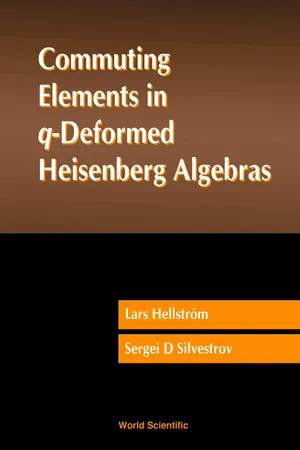
- 272 pages
- English
- PDF
- Available on iOS & Android
Commuting Elements In Q-deformed Heisenberg Algebras
About This Book
Noncommutative algebras, rings and other noncommutative objects, along with their more classical commutative counterparts, have become a key part of modern mathematics, physics and many other fields. The q-deformed Heisenberg algebras defined by deformed Heisenberg canonical commutation relations of quantum mechanics play a distinguished role as important objects in pure mathematics and in many applications in physics. The structure of commuting elements in an algebra is of fundamental importance for its structure and representation theory as well as for its applications. The main objects studied in this monograph are q-deformed Heisenberg algebras — more specifically, commuting elements in q-deformed Heisenberg algebras.In this book the structure of commuting elements in q-deformed Heisenberg algebras is studied in a systematic way. Many new results are presented with complete proofs. Several appendices with some general theory used in other parts of the book include material on the Diamond lemma for ring theory, a theory of degree functions in arbitrary associative algebras, and some basic facts about q-combinatorial functions over an arbitrary field. The bibliography contains, in addition to references on q-deformed Heisenberg algebras, some selected references on related subjects and on existing and potential applications.The book is self-contained, as far as proofs and the background material are concerned. In addition to research and reference purposes, it can be used in a special course or a series of lectures on the subject or as complementary material to a general course on algebra. Specialists as well as doctoral and advanced undergraduate students in mathematics and physics will find this book useful in their research and study.
Frequently asked questions
Information
Table of contents
- Contents
- Preface
- Acknowledgments
- Chapter 1 Introduction
- Chapter 2 Immediate consequences of the commutation relations
- Chapter 3 Bases and normal formin H(q) and H(q, J)
- Chapter 4 Degree in and gradation of H(q, J)
- Chapter 5 Centralisers of elements in H(q, J)
- Chapter 6 Centralisers of elements in H(q)
- Chapter 7 Algebraic dependence of commuting elements in H(q) and H(q, n)
- Chapter 8 Representations of H(q, J) by q-difference operators
- Appendix A The Diamond Lemma
- Appendix B Degree functions and gradations
- Appendix C q-special combinatorics
- Appendix D Notes on notations
- Bibliography
- References by topic
- References
- Index